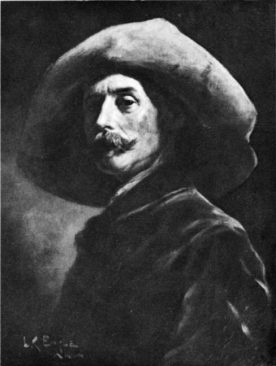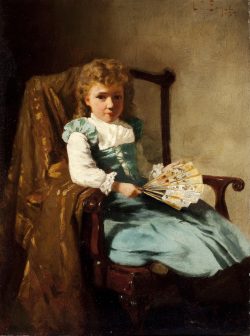Lawrence Carmichael Earle, Self Portrait, circa 1900, oil on canvas (23½ by 17½ inches), collection of the Montclair Art Museum

L. C. Earle 1845–1921
Lawrence Carmichael Earle was raised in Grand Rapids, Michigan, where he received his first art instruction from Marinus Harting, a Dutch immigrant artist. Earle was an enthusiast for the infant sport of baseball, joining the Kent Club, the city’s first team, in 1867, and sketching the players. He arrived in Chicago in 1868 to study under Walter Shirlaw at the Chicago Academy of Design (predecessor of the Art Institute of Chicago), where he later taught such painters as Alice Kellogg Tyler. Earle attended the Royal Academy in Munich and worked in Florence and Rome. He returned to Chicago in the early 1880s and began painting pictures of animals. He served on the art committee for the 1882 Interstate Industrial Exposition in Chicago, and he was represented in the public collection gathered under the auspices of the Illinois Art Association. He was “a leader among the painters, prominent in all their gatherings, energetic, ambitious, and widely popular,” according to Lucy Monroe in her 1892 chronicle of art in Chicago.i
Earle apparently established studios in both New York and Chicago as early as 1881, and within a few years he was exhibiting widely. He first showed in the Boston Art Club exhibitions in 1887, and the following year he began participating in the annual exhibitions of the National Academy of Design in New York and the Pennsylvania Academy of the Fine Arts in Philadelphia, in addition to the Art Institute. Around 1890 he was living in New York, and five years later he moved to Montclair, New Jersey, where he was active in local art affairs. Earle remained involved in the Chicago art world, however. He painted two mural decorations, on the themes of pottery and glassblowing, for the Manufactures and Liberal Arts Building at the 1893 World’s Columbian Exposition. Beginning in 1900, he undertook a more ambitious project: a cycle of sixteen murals illustrating stages in Chicago’s development for the main banking room in a new building for the Central Trust Company (later Chicago National Bank), on Monroe Street. In 1907 the Art Institute recognized Earle with an honorary membership. Two years later, the artist settled once again in Grand Rapids, where he continued to paint. He was honored with a solo exhibition at the Detroit Museum of Art (now the Detroit Institute of Arts) in 1909 and with others at the Grand Rapids Art Association in later years.
A facile painter of landscapes, figural works, portraits, and still lifes, Earle was noted for his character studies and ethnic types. He created the original image for the Dutch Boy house paint logo, reportedly while working in the Montclair studio of the late landscape painter George Inness. Earle belonged to numerous clubs and arts organizations in New York as well as Chicago, and he was elected an associate member of the National Academy in 1897. In addition to oil painting and mural decoration, Earle also excelled in watercolor. An astute admirer of the medium, he became one of the first collectors of Winslow Homer’s watercolors when he purchased several at a Chicago auction in 1879.
Wendy Greenhouse, PhD
i Lucy Monroe, “Art in Chicago,” New England Magazine 6 (June 1892): 420.
